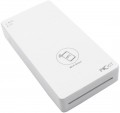Printer print speed in photographic (highest) quality. Unlike other similar parameters, in this case the speed is usually indicated for a 10x15 sheet (A6, the most popular format for photographs). In addition, photo printing speed is not expressed in pages per minute, but in seconds per page, because. printing takes a lot of time. This option is worth paying attention to if you plan to
print photos frequently.
—
Connection to PC (USB). Possibility of wired connection with PC via USB interface. Do not confuse this function with the USB connector described above: in this case, the peripheral device is the printer itself. This option is the most popular way of wired connection to a computer nowadays: there are USB ports in almost any PC or laptop.
—
Network connection (LAN). Possibility of wired connection to a local computer network through a standard LAN connector (using an Ethernet cable). With this connection, the printer becomes available to all computers on the network — this is very convenient for offices, co-working spaces and other places where different people have to use printing from different computers. Note that the connection to the network can be carried out both through one of the computers of this network, and through a common router; in the second case, the printer remains operational regardless of which computers on the network are currently turned on. Compared to another connection option — Wi-Fi — a wired connection is less convenient due to the need to run a cable; however, it is cheaper, and the connection is as reliable as possible.
—
Wi-Fi. A wireless technology that was originally designed to work with computer networks, but nowadays is also used for direct communication between devices (
Wi-Fi Direct, see
...below). Usually, printers with Wi-Fi can work as network devices — when communication is carried out via LAN, and all computers on the network have access to the printer; but the possibility of direct connection of gadgets is less common. However, the specific functionality of Wi-Fi anyway needs to be specified separately.
— Card Reader. Slot for reading memory cards, usually, with the function of direct printing (see above). In this case, this function is convenient primarily because memory cards are widely used in modern photo and video cameras; thus, the card reader allows you to quickly and conveniently print the footage — just remove the card from the camera and install it in the printer. However, this function can be useful for exchanging data with other devices — for example, laptops; and in some printer models it is even possible to work in the mode of an external card reader for a PC.
— USB. USB connector that allows you to connect various external peripherals to the printer. Most often used for direct printing from flash drives and other drives, however, it can also be used for other purposes — for example, for updating firmware, diagnosing problems, etc. Do not confuse this function with connecting to a PC via USB when the role of a peripheral device is played by the printer itself (see below for details).
— Bluetooth. Direct wireless communication technology between different devices. In printers, it is used mainly for the traditional purpose — to receive materials sent for printing from external devices. One of the advantages of such a connection is that it allows you to work not only with computers, but also with portable gadgets like smartphones and tablets: built-in Bluetooth modules for such gadgets are almost mandatory, but wired connection methods are most often not available at all. Yes, and it can be more convenient to communicate with a PC or laptop in this way: Bluetooth does not require wires and works confidently at a distance of about 10 m.
— NFC. Short-range wireless technology — up to 10 cm. In printers, it is usually used as an auxiliary function to simplify communication via Wi-Fi and Bluetooth: instead of setting up the connection manually, just bring an NFC gadget to the printer and confirm the connection. And in some models, in this way (by bringing the device to the printer), you can even immediately send materials for printing; To do this, usually, you need to install a branded application on an external gadget.
— Wi-Fi Direct. A feature found on models with built-in Wi-Fi modules (see above). Direct support allows you to connect other Wi-Fi devices (laptops, smartphones, cameras, etc.) to such a printer directly, without using a router and a local network. This can be especially convenient if there is no network equipment, or if it needs to be additionally configured. The functionality of the Wi-Fi Direct connection is generally similar to Bluetooth (see above); the main difference is that Wi-Fi provides a faster and more reliable connection, with longer range. This is especially true when transferring large amounts of data — for example, sending large documents for printing. In addition, such a connection is better suited for direct printing from cameras — Wi-Fi is traditionally used for wireless connection in this technique.
— AirPrint. Same function as above (Wi-Fi Direct). Allows you to connect to the device without using a router. However, in this case, we are talking about connecting Apple equipment — iPhone phones, tablets, Mac laptops.
